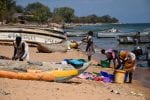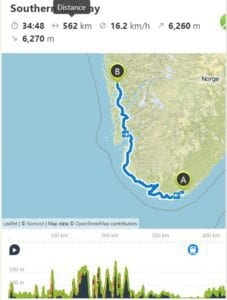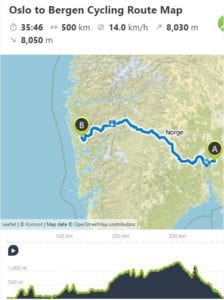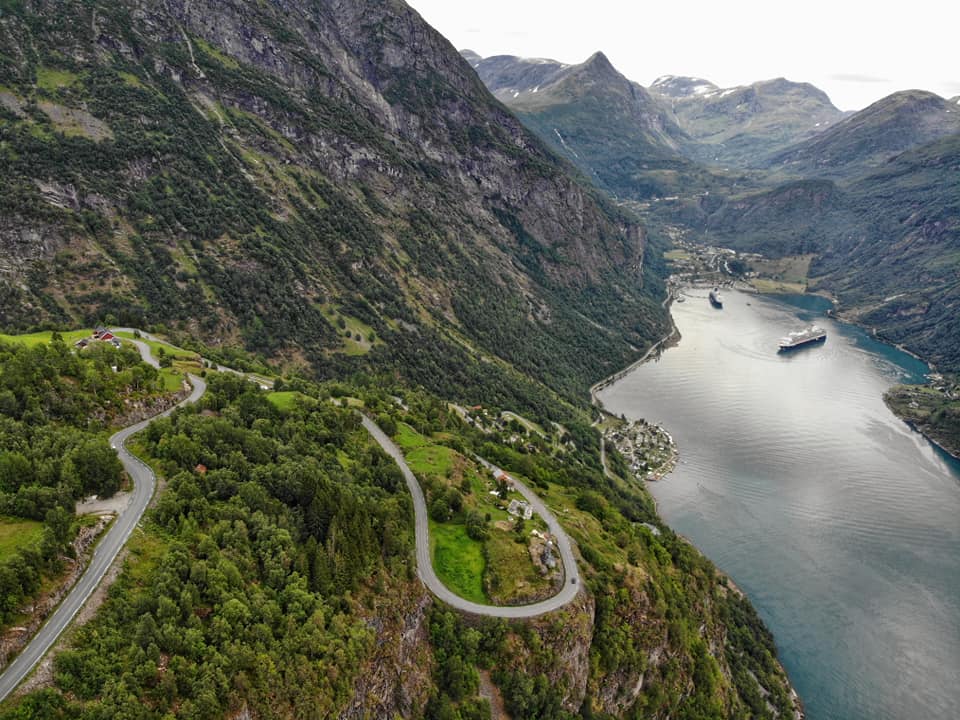Last Updated on 3 September 2024 by Cycloscope
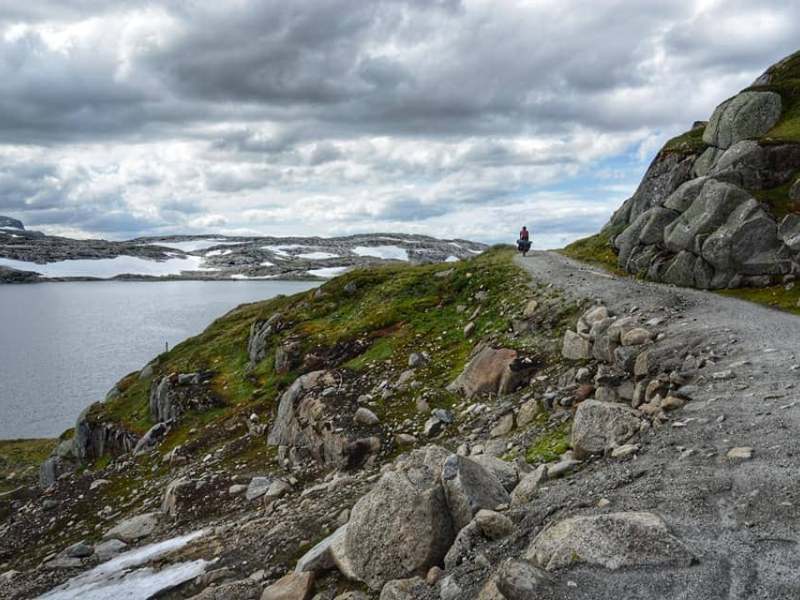
Cycling Norway – The Ultimate Guide for Bicycle Touring and Bikepacking
Norway is the ultimate European destination for all kinds of cyclists. Expert bicycle travelers, road cyclists, avid mountain bikers, all of you will face the embarrassment of choice when starting to plan your bicycle trip in Norway.
Norway has certainly all it takes to make even a short cycling holiday into the trip of a lifetime, but of course, reserves its best for those who are willing to accept all the challenges it offers, and they are many, fierce, and rewarding.
There are a lot of things to consider when cycling in Norway, in this blog article we’ll try to cover them all and be as complete as possible. Please feel free to contribute in the comments section and help improve this article.
Map of points of interest in Norway – natural wonders and scenic roads
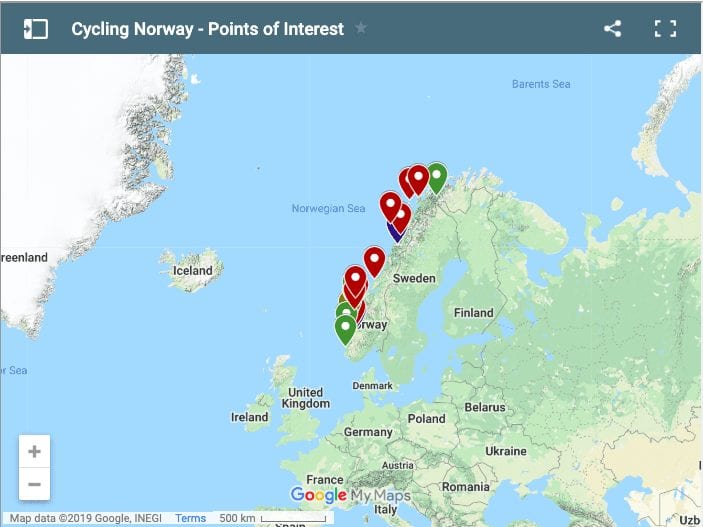
Norway is scenic everywhere, here we just collected a few major spots for you to have a quick glance and start organizing your bicycle trip. Some itineraries are outlined down below in this article, we’ll get deeper into detail in a series of upcoming articles.
Weather in Norway (and how it affects bike touring)
Weather is rarely a friend to the adventure cyclist here, we ourselves had our morale knocked out during several days of unremitting rain.
Norway is very extended in latitude and has a rugged coastline, plateaus, and mountain ranges, so there are different climates to be taken into account.
Weather along the Norwegian Atlantic Coast is wet, characterized by the frequent passage of weather fronts so that clouds, rain, and wind dominate throughout the year.
The forecast for this region is greatly unpredictable, it might pour down rain just above you while on the other side of the fjord, maybe just 200 meters away, the sun might shine through a nitid double rainbow. This makes for truly epic skies and mesmerizing colors, but also for a lot of swearing and miserably wet and foggy days.
Fortunately the Gulf Stream “positively” affects the temperatures, making them milder than in the inland areas, especially in winter when they rarely go below -7°C. The area of Bergen is among the wettest in the world, with annual precipitation of about 2,200 millimeters.
The North Coast, Finnmark, and Troms regions, including Nordkapp, lay entirely in the polar region, precipitations and the weather here is very similar to the Atlantic Coast, maybe a bit less wet but slightly colder. Also here temperatures never get too unbearable, but winds are stronger.
The South Coast is more temperate and less wet, with a higher average of sunshine, while the Oslo region has a Baltic climate, with hotter summers and colder winters.
The inner regions, along the Swedish border, have a continental climate, with cold and snowy winters, and mild summers. Typically the interior is covered with hills and mountains, the temperature decreases with altitude turning into a mountain climate even at not-so-high elevations. The snowline in Norway is quite low, about 1,500msl.
The southern Finnmark is considered part of Lapland, with an explosive short summer and long freezing winters (the coldest temperatures in Norway are registered here, -50°C in 1999)
Best time to cycle in Norway
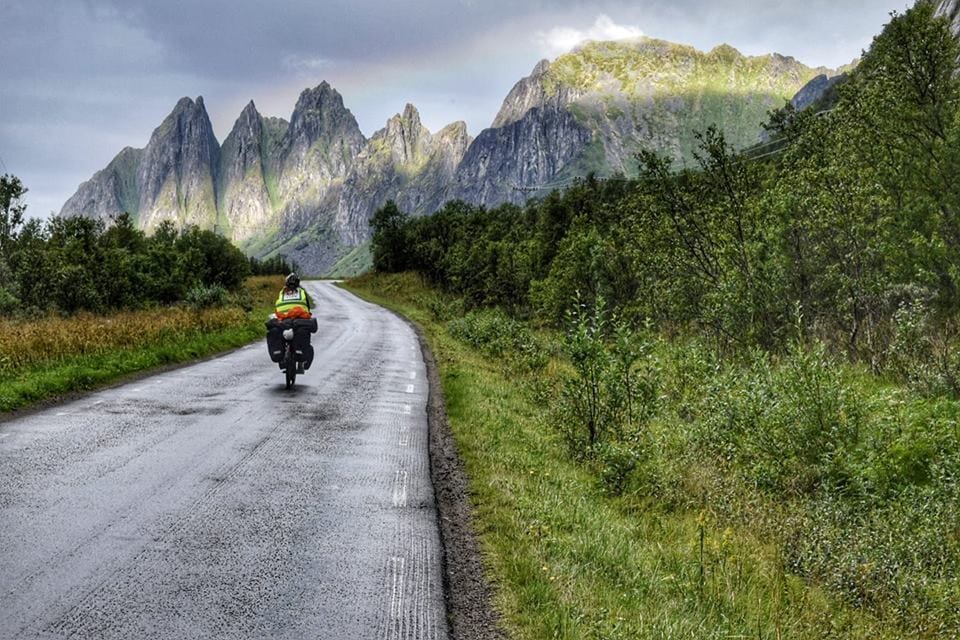
Although winters in most of Norway are dryer than summers and not so cold, Summer is still the best season for cycling in Norway.
Winter days are just too short for such a big country, and cycling in polar nights will deprive you of the visive orgasm of the landscape (sure you could be delighted by some northern lights, that’s also true).
Summer days are instead neverending, the sun doesn’t set in Tromso from May 21st to July 21st. Long days even at low latitudes allow for more cycling distance, and more time for photography, besides the experience of neverending seamless sunset and sunrise called Midnight Sun.
Roads of Norway
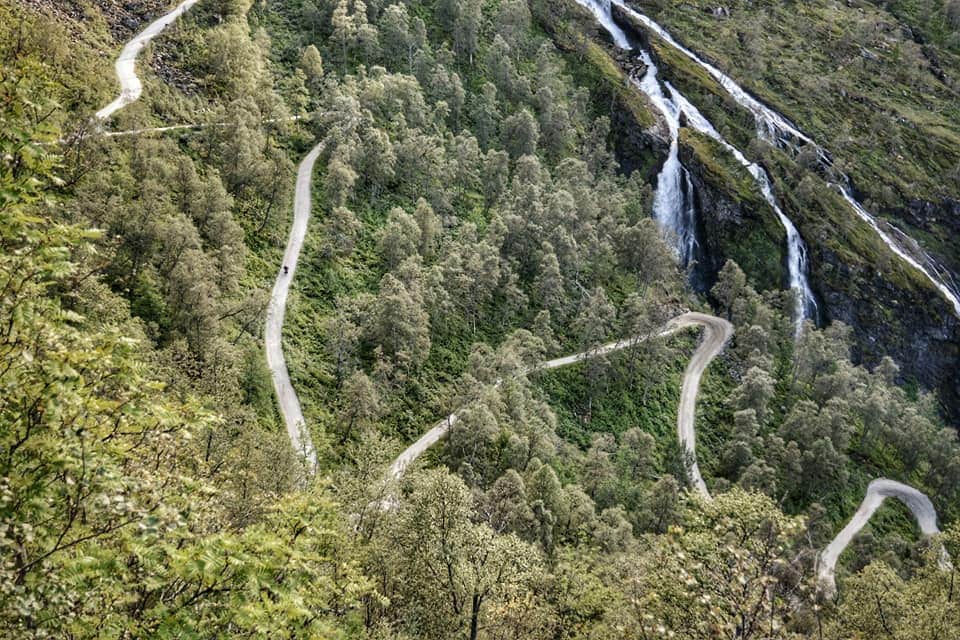
Most roads in Norway are perfectly paved but narrow, side emergency lanes are a mirage. The country is a constant up and down, even though not too demanding outside the southern mountainous areas, you’ll still need good legs to cycle in Norway, not really a beginner’s affair.
Traffic on Norwegian Roads
Due to the lack of proper highways in the country, motorized traffic might be medium-heavy to heavy on major roads during peak seasons. Road 7, for example, is the main connection between Oslo and Bergen and was a pretty nightmarish ride during national holidays in July.
The same goes for E10 through the Lofoten Islands. Roads marked with E (European) are generally busier, although less so in the northern regions.
Cycling paths
Considering how “advanced” and “green” Norway is considered (and loves to consider itself), there are surprisingly few long-distance cycling paths, if none at all. Besides the Rallarvagen, the only proper cycling path we saw was the one connecting the Oslo airport with the city center, a 56km dedicated path leading into the heart of the Norwegian capital.
The Eurovelo 1 route, going along the Atlantic coast of Europe, has a Norwegian section connecting Bergen to Nordkapp. This is anyway 99% on motorways, sometimes on medium-heavy traffic roads, and poorly signposted.
The feared and infamous Norwegian Tunnels

Given its rugged landscape, Norwegian roads are often forced into tunnels to get past fjords and mountains. There are over 1,000 tunnels in the country, some are among the longest in the world.
Tunnels are a real nuisance when planning a route across Norway, luckily the guys behind CycleTourer have put together a map of all the tunnels in the country, it will be your best friend almost daily. Check it out here.
We could divide Norwegian tunnels into 3 categories:
- Tunnels are forbidden to cyclists – these are the longest ones, and there are many. Sometimes there are alternative roads going around, sometimes you have to either hitch a ride or take an expensive bus to go through. (marked red)
- Tunnels allowed but dangerous – sometimes long and poorly lit (marked yellow)
- Tunnels which are just fine to cycle (marked green)
Some tunnels have a special system that notifies the drivers of the presence of a cyclist. All you have to do is stop and press a button before entering the tunnel, a light will turn on beside a sign saying “Syklist I tunnel'”. We only saw this in Senja, where there were also free reflective vests available (in a box right next to the button).
Do not attempt to cross forbidden tunnels, you will almost surely incur a big fine, besides seriously risking your life. The longest tunnel may be filled with carbon monoxide from vehicle fumes due to poor ventilation.
Geography of Norway
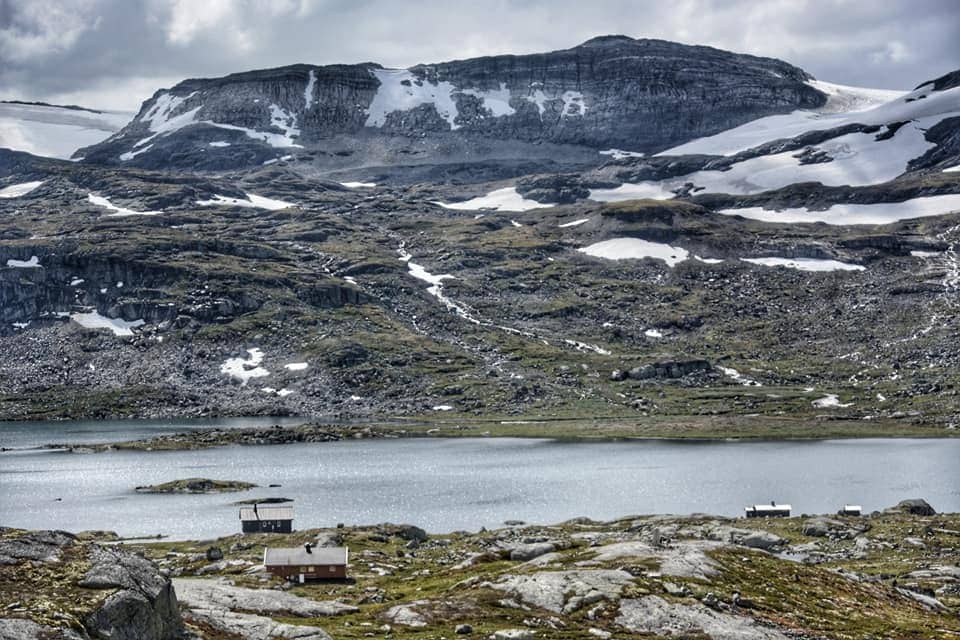
Norway was covered by ice during the last ice age about 10,000 years ago. The melting of the glaciers formed islands, lakes, rivers, fjords, and mountains. Freshwater lakes are indeed very common throughout the country (more than 150,000).
Almost the whole coastline (besides the southern coast) is ripped off by fjords, making the landscape an everchanging marvel but slowing up the travel time due to the constantly winding roads and the enormous amount of ferry crossing needed to make one’s own way along the Atlantic coast.
Mountains of Norway
The highest mountains are in the southern regions between Bergen and Kristiansund, in the central-eastern area. Although just a few peaks reach above 2,000msl, Norwegian mountains look and behave like much larger mountains, with spectacularly barren landscapes and a quickly changing climate.
The most prominent mountain ranges are Jotunheimen (the tallest), Hallingskarvet National Park (crossed by the famous Rallarvagen cycling route), Breheimen, and Reinheimen.
Further north, the Scandinavian Mountains are much lower reaching altitudes of no more than 1,500 msl and creating a natural border with Sweden.
Vegetation
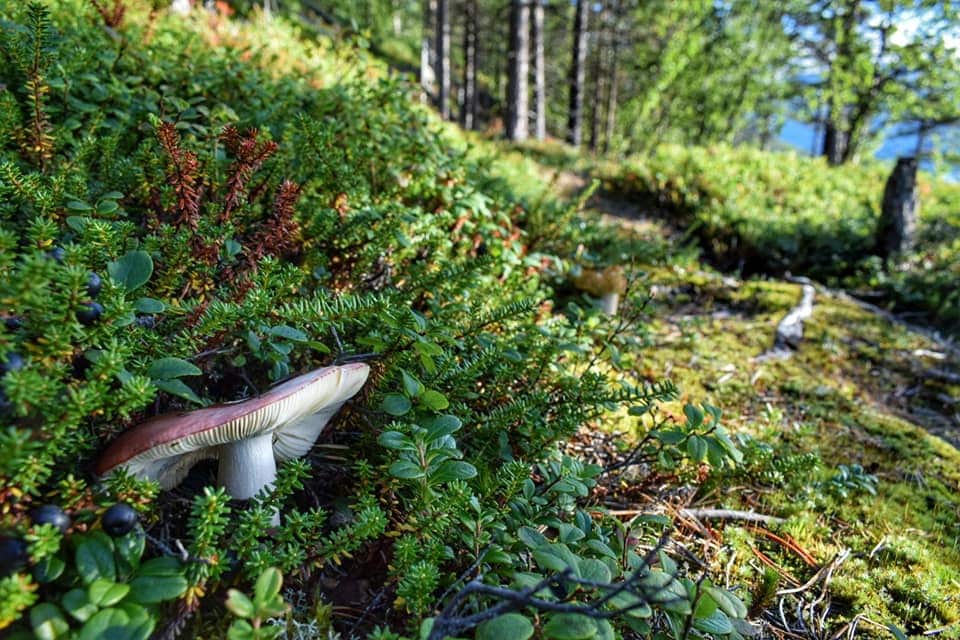
The altitude of the treeline goes down going towards higher latitudes; in northern Finnmark (the northernmost region of Norway), the treeline reaches sea level. The treeline is also lower near the coast and higher on the eastern slopes of the mountains.
Forests cover slightly more than one-fourth of Norway’s land area. Mainly deciduous forests are found in the coastal areas of southern and southwestern Norway. The principal species are birch, ash, hazel, elm, maple, and linden, but in some locations oak, yew, and holly may be found. To the east and north, the forests contain increasing numbers of conifers.
Thick boreal coniferous forests are found in coastal regions and in the valleys of eastern and central Norway. These forests are dominated by Scotch pine and Norway spruce but also contain birch, alder, aspen, and mountain ash.
Wild berries, such as the blueberry, lingonberry (the fruit of the mountain cranberry), and cloudberry, grow in most woodland areas. In the far north and at high elevations are tundra regions. (from Countriesquest.com)
Only the northernmost areas of Finnmark are considered tundra, although north of Trondheim and away from the coast the landscape is mostly treeless with a few low and contorted birches as the only species of tree.
Glaciers of Norway
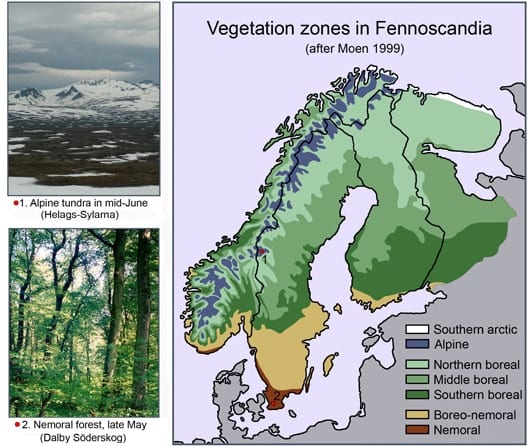
Together with Iceland, Norway hosts the few remaining ice age glaciers in Europe, including Folgefonna, Svartisen, Hardangerjokulen, and Jostedalsbreen – the largest glacier on the continental Europe landmass.
Specs of the Jostedalbreen may be glimpsed from the road near Skei (some forbidden tunnels in the way, though), while the Hardangerjøkulen is clearly visible from the unmissable Rallarvagen. The Svartisen is easily accessed from Kystriksveien – rv17, south of Bodo.
Norwegian Fjords
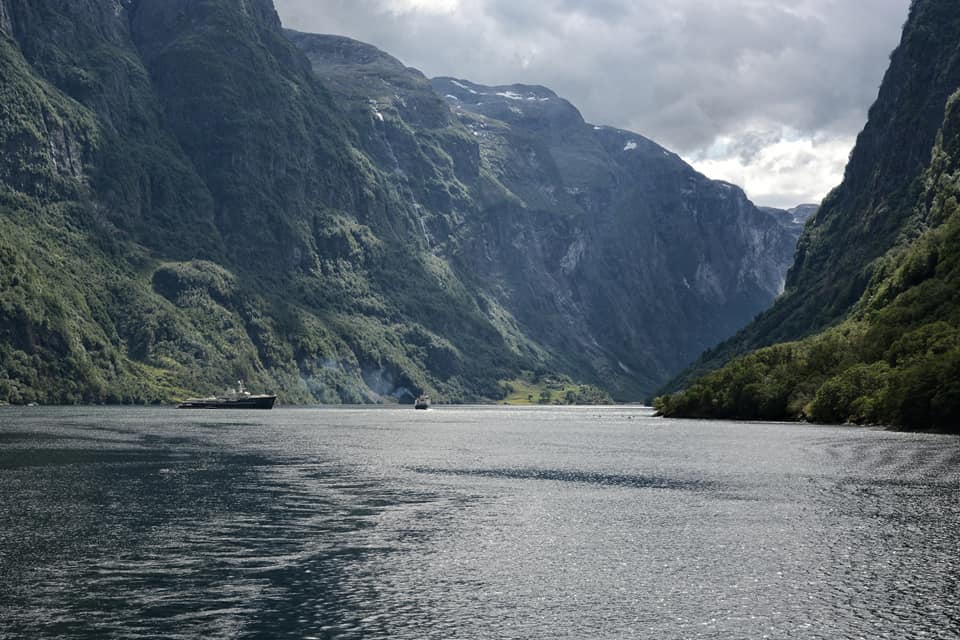
Norwegian dented western coastline is a jagged expanse of more than 50,000 islands and dozens of long, deep fjords; Among the most famous Norwegian fjords are:
- Sognefjord (the longest in the world, 203km)
- Boknafjord (one of the widest, with hundreds of islands, situated in the scenic Stavanger region)
- Geirangerfjord (from where to access the epic Eagle Road and Trollstingen Road)
- Hardangerfjord (near Bergen)
- Moldefjord
- Lyngenfjord (near the spectacular and underrated Lyngen Alps)
Where to Stay in Norway
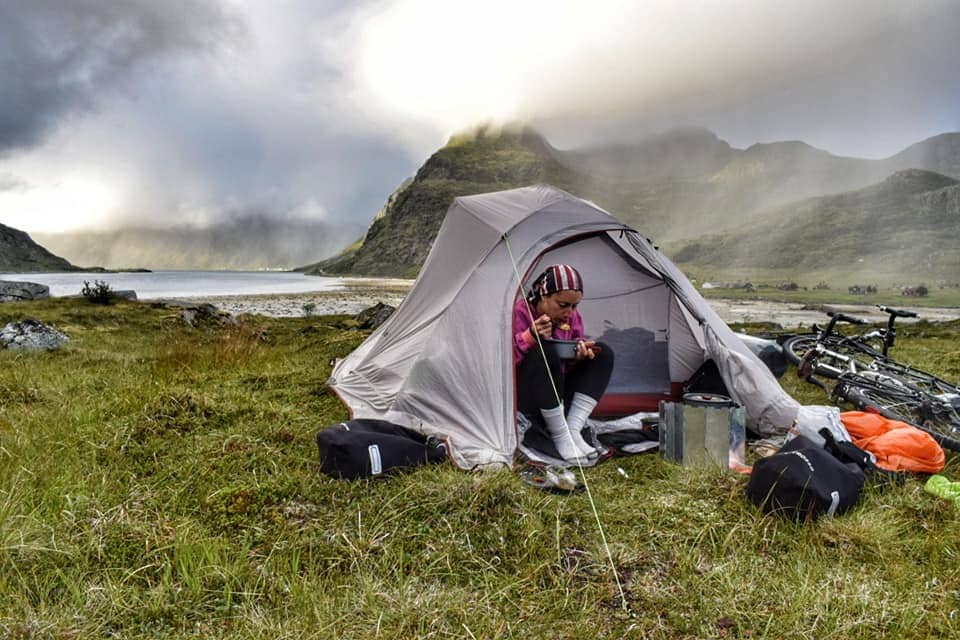
Wild Camping in Norway – The “right to roam” and the forbudt philosophy
Norway, as well as the other Scandinavia Countries, is famous among nature lovers for its law called “right to roam” allemannsrett in Norwegian (lit. the everyman’s right), a traditional right from ancient times.
This basically states that: “In Norway, you can walk nearly anywhere you want […] You may put up a tent, or sleep under the stars, for the night anywhere in the countryside, forests or mountains […]”.
As cool as it might seem, there are some rules to be followed, and Norwegians are strict and not very forgiving about rules, so you better stick to them:
- People are allowed to camp at least 150 meters away from the nearest inhabited house or cottage.
- Campfires are not allowed in the forest areas from 15 April to 15 September.
(when we were there, in the abnormally hot and dry summer of 2018, this rule was even more strictly applied, forbidding the use of any open flame in outdoor areas, even in private gardens. This included camping stoves and single-use barbecues) - Tourists are allowed to stay in one spot for only one day. After that, it is necessary to specifically ask for permission from the landowner. This rule excludes the mountains and the national parks.
Adding to the fact that camping is forbidden in almost all serviced public areas (usually the ones with a toilet and trash bins, mostly beaches and parks, as a matter of fact, these rules sometimes widely restrict the camping options in Southern Norway.

Considerations on free camping in Norway – our experience
On our first night in Norway, we immediately had to face the archetypical “old ladies civic sense”. Because of a mechanical problem we were forced to camp near Jessheim (a town close to Oslo airport). There is a parc surrounding a lake there, on the beach there’s an explicit sign forbidding camping but there were no such signs in the forest around.
We pitch the tent there shortly before sunset, while several locals were jogging or walking in the woods. Two times old ladies stopped by to tell us (in a quite rude way, I might add) we were not allowed to camp there. Shortly after sunset two policemen came, evidently called by one of those old ladies. They were very polite and confirmed us overnight camping was indeed allowed in that area.
I tell this story to state that “every man’s right” is not totally tolerated. Many other countries in the world allow free camping with less strict rules and more friendliness, we never had people complaints in any of the 35 countries cycled so far.
That said we always found at least a half-decent camping spot for the night without having to struggle too much, the situation greatly improved on the mountains around Bergen and north of that, with some of the most scenic camping spots ever.
Best spots to pitch your tent in Norway
Unfortunately, given the harsh and wet climates, there’s a lack of widespread free shelters in Norway, meaning that very simple roofs, porches, or gazebos are a mirage… forget about the Finnish Lavu or Korean Gazebos (there’s a network of wilderness huts, more about them later).
The forest offers some protection from rain and wind but not from humidity and cold. The mosses of Northern Norway are soft sleeping grounds providing solid holds for the stakes. Finding a camping spot near a water body is usually easy.
The DNT cabins – often mistaken as Norway-free huts
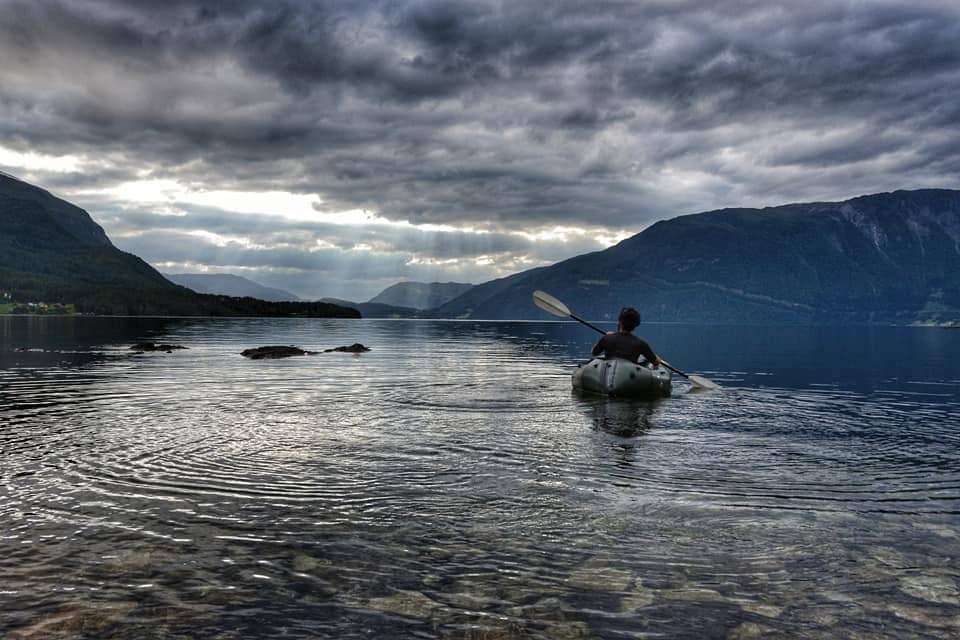
The Norwegian Trekking Association (DNT) maintains a network of about 550 cabins across the whole country. There are three types of lodges in the DNT network:
- Staffed lodges: those are basically hotels or hostels, there are people working there, usually running some sort of restaurant. A bunk bed in 1-3 beds rooms costs 357 NOK per person for the members.
- Self-Service Lodges: those are unstaffed cabins supplied with stocks of food. You’ll need the key to open them (sometimes there’s a unique key to collect, and the passe-partout won’t work everywhere), and some also need pre-booking. You need to fill out a module to pay for food and accommodation. Member’s price is 275 NOK per person, not so cheap!
- No-Service Lodges: These don’t have any food provisions. You still have to pay for sleeping, the same as the self-service ones. Some of these might be open, not requiring a key, although usually those open ones are remotely located along some hiking trails.
To access member prices and get the (almost-)universal key you need to be a DNT associate. Annual membership is 650 NOK (350 if less than 26 years old).
We honestly don’t think the DNT cabins can be very useful for cyclists, except maybe for very adventurous mountain bikers. The few cabins near the roads are those staffed ones, although we saw three Self-Service ones we would really have loved to get into, they were about the same price as a basic private cabin… add the fact that most need pre-booking and you’ll see how hard is to use them for a bike tourer.
Campsites in Norway
There are over 1,000 privately owned campsites in Norway, they are literally everywhere, especially in the South, but also in the remoter regions of the north you’re rarely more than a cycling day distance from the next ones.
Almost all Norwegian campsites have cabins, those are the most affordable form of proper accommodation in Norway. They are especially convenient when traveling in groups of three, four, or more persons since most of them have four to six bunk beds but no price difference for one or two people.
The price of camping cabins (Hyttekos in Norwegian) ranges from a minimum of 400 NOK (€42), with prices skyrocketing to 200/300€ for a very basic cabin in the Lofoten Islands in high seasons. Most campsites have basic cabins starting at 600NOK in summer, shared toilets and facilities, and basic cooking equipment (rarely running water) are often present in the cabin itself.
Most of these campsites are open whole year-round, the cheaper cabins usually have electric radiators, while higher-end ones might even have a fireplace.
Campsites in Norway are mostly small and cozy (excluding the one in Oslo and a few caravan parks), there’s always a shared kitchen and often a closed barbecue hut. Showers are almost always excluded from the basic fee, costing 1/2€ for 4/5 minutes of hot water. You learn how to shower fast in here.
Washing machines and dryers are ubiquitous in Norwegian campsites usually costing 4/5€ each.
The price for a tent in a Norwegian campsite goes from 100 to 200 NOK (12-22€)
Hotels and Hostels in Norway
Hotels are expensive in Norway, starting at about 70€ but more often around 100€ or more. We slept only once in a hotel, the Thon Hotel near the Oslo Gardermoen Airport. Thon is a chain of spread and good value (for Norwegian standard) hotels with a very huge buffet breakfast often included, we paid 65€.
Hostels are present only in major cities or towns, costing an average of 30€ per person per night in a dorm. Airbnb is not much cheaper. All of these prices are considered for high season, in lower season prices can go down to half.
Couchsurfing and Warmshowers in Norway
A not-that-big community, the huge number of bike tourers and travelers in general in high season, together with the typical Norwegian love for solitude, make finding a host a very difficult task.
We only succeeded twice and none of our hosts was a Norwegian, don’t count on that to get some rest from the hardship of the road, you’ll most likely have to pay for accommodation.
For those who don’t know what Warmshowers and Couchsurfing are, check this out.
Costs of Cycling in Norway
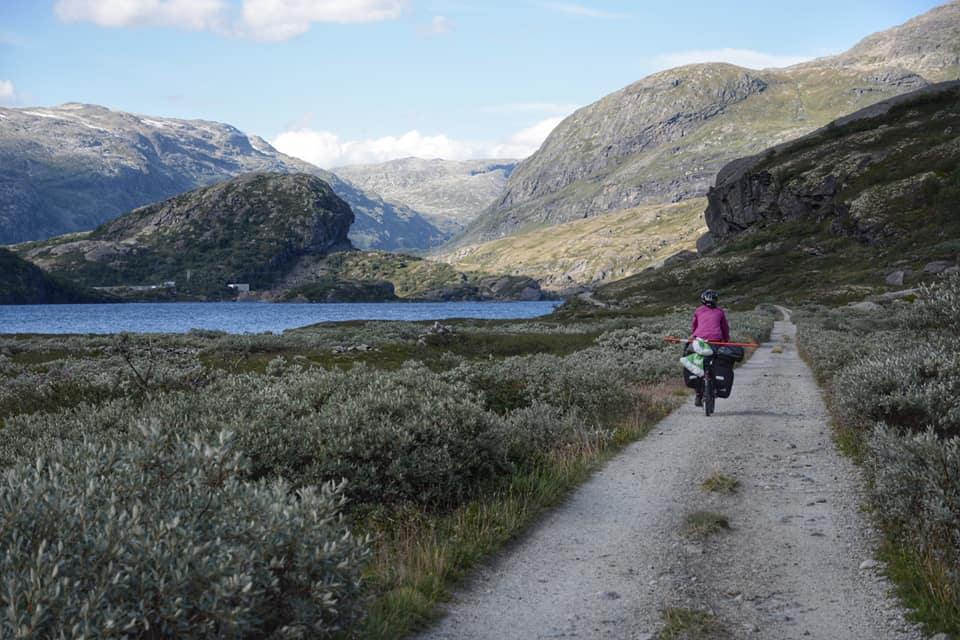
Norway is one of the most expensive countries in the world, we thought we had figured out how to budget travel to an expensive country but Norway really broke our bank.
Food is incredibly expensive, 35% to 45% more than in the UK both for groceries and restaurants, accommodation is sky-high, more so if you’re alone or a pair, add to this the cost of the ferries required if you choose to travel the coast (sometimes more than one ferry per day), the insane price of the beer (8/10€ draft, 3.5€ for a can), the bus rides (sometimes needed to pass a tunnel), and you can easily see how we ended up spending more than 25€ each per day, two and a half times more than our average, 3 times more than what we spent in Japan.
Our costs breakdown
Although we stayed in Norway for 40 days, in order to give a more readable report we projected the costs for 30 days here. The total cost of the 30 days trip was 14,680 NOK (1,523€ – 1,740USD), which means 490 NOK per day for 2 persons, 245 NOK per day per person.
- Food: 5,500 NOK
- Accommodation: 3,900 NOK
- Transportation: 4,760 NOK
- Beer: 520 NOK
These numbers are more than double our average expenditures, it is important to state that we spent this much because we had it, because we didn’t want to compromise our route, because we used campsites and a few cabins to make our rest after a seamless rainy day less miserable.
We met several people traveling with half this budget, so it can be done. You’ll need to plan your route in order to use fewer ferries, wild camp all the way, and forget about showers and beer. Consider trying dumpster diving.
What to bring for a bicycle touring expedition in Norway
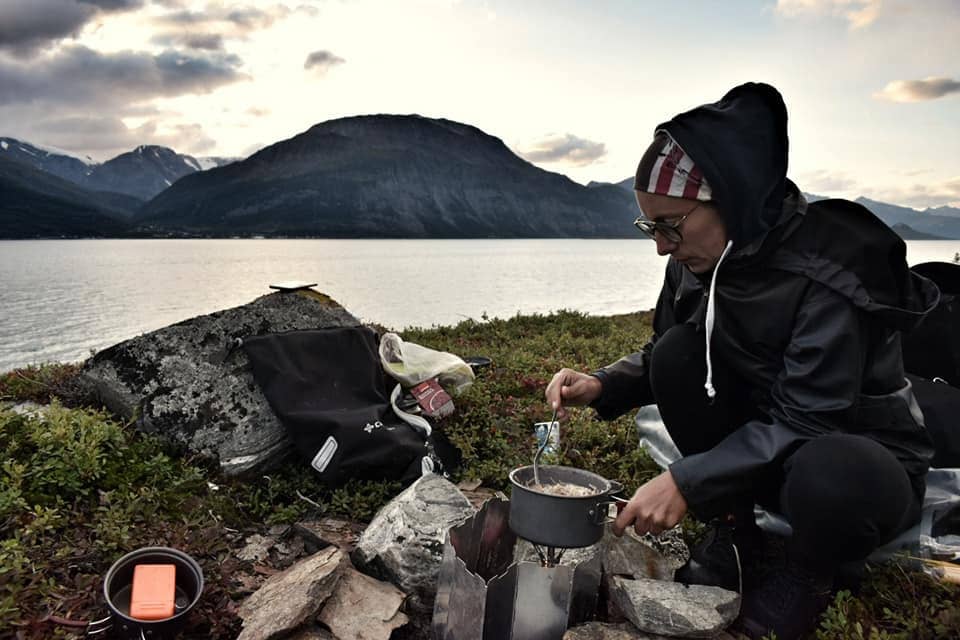
Unless you have a very big budget, or you’re going for a short cycling holiday, you’ll have to be totally self-supported in order to cut down the huge costs.
Bring complete camping gear, 4 season tent is a plus while a 2°/0°C comfort sleeping bag is a must even in Summer. For a thick and high-rated sleeping pad, consider linens. Bring a stove and pots, standard gas canisters are widely available.
Clothing should include base layers, merino wool sleeping clothes, leg warmers or long pants (better both), hardshell jackets and Windstopper (softshell), warm gloves, and ear-covering wool hat; we also used a thin but warm down jacket we were glad to have while cooking in the evening.
All of the above is for summer (late spring/early autumn), things can get chilly even during the daytime, especially at higher latitudes or altitudes. We will cover winter clothing in an upcoming article.
Rain gear is what makes the difference between a miserable day and a very miserable day. Succeeding in having at least the more hidden parts of your body dry after an all-out rainy day should be your aim. We used Naturehike’s long poncho on a waterproof jacket, rain pants, and shoe cover.
Don’t make the mistake of visiting Norway without a decent camera, those marvels are worth memories. Another thing, if you want to get into the Norwegian atmosphere, you could also start reading some books about Norway.
Choosing a route – Norway cycling itineraries
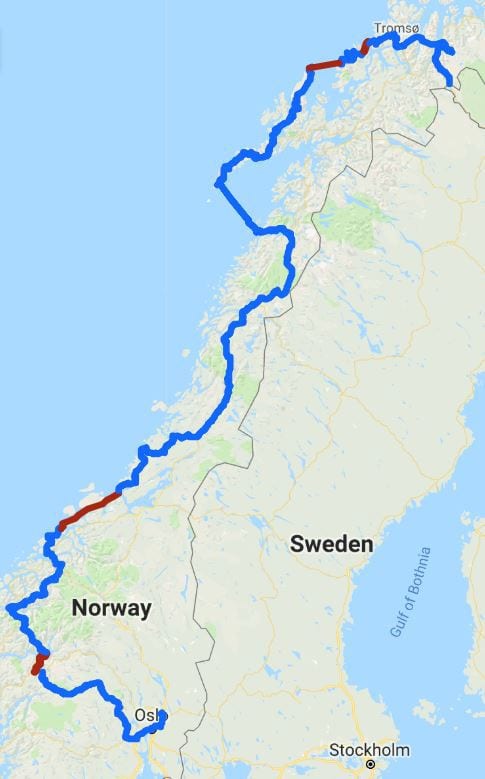
With a length of 2,544km, 21,525km of coastline, and a road network of more than 90,000km, there’s no lack of choice of where to cycle in Norway.
Every year hundreds of adventure cyclists ride their own way to or from Nordkapp, while thousands embark on shorter but often not less demanding bicycle trips.
We cycled from Oslo to Tromso in 40 days, at a slow pace of about 60km per day, using ferries and even getting a car ride from friends during the passage of a very bad weather front.
If you don’t want to cycle the whole country here are some ideas, they are all worth it.
You can click on the maps below to navigate them into a new window
Southern Coast – Kristiansund to Bergen
Maybe not the most exciting route at first, it becomes spectacular on the Stavanger – Bergen section
562Km suited also for beginners despite the ups and downs
The Mountains – Oslo to Bergen
A demanding one, there are several ways to reach Bergen from Oslo but all require crossing some high, wild, and scenic mountains. The Oslo area is also hilly and might be busy on major roads.
The Rallarvagen is an absolute must, maybe the most beautiful two-day ride in our whole cycle touring experience so far.
The Fjords and scenic routes (Eagle Road, Trollstigen, Atlantic Road)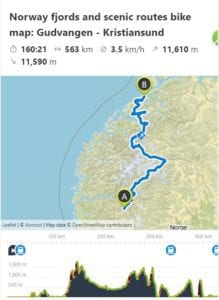
Norway takes your breath away almost everywhere, but this route has a high concentration of some of the most epic rides the country has to offer. Long ferry crossings of some of the most scenic fjords, the steep and marvelous challenges of the Trollstigen (one of the most dangerous roads in Europe) and the Eagle Road, the gravity-defying bridges of the Atlantic Road, and the wild peaks of the Jotunheimen National Park (where the highest mountains in Norway are).
Depending on your fitness and willingness to suffer you might use some unpaved tracks to cross the Jotunheimen (great mountain bike rides) or avoid it entirely by going to Skei (a bus ride is needed because of a long tunnel).
Strong legs are needed for this 563km route. The route on the map is just an outline, it might start from Gudvangen or Flam, and you could include the gorgeous Flåmsbana, the train ride between Flam and Myrdal.
If you want to start there, check out this article about how to reach Flam from Bergen.
Central Norway – Trondheim to Bodo
This is often an overlooked route but for no real reason. There are two main options, the inland road, and the Atlantic coast.
The inner route runs through some barren tundra-like scenery, on the main road which doesn’t see a lot of traffic. Temperatures are lower but the weather should be drier.
The Atlantic route is scenic, very wet, requires a lot of ferries, and goes on minor and remoter coastal roads. You will pass the Svartisen Glacier and the biggest whirlpool in the world, the Saltstraumen, near Bodo.
Pearls of the Arctic – Lofoten and Vesterålen Islands
Pure artic marvels, cycling here will leave an indelible print in your memories.
While Lofoten has seen a significant tourist boom in the last decade, some areas of the Vesterålen are still wild and off-the-beaten-track.
Stunning white beaches, crystal clear waters, towering cliffs, tiny islands, wooden houses straight above the fjords, alien-looking scientific research stations, an unbelievable variety of mosses… a mostly flat ride that will make you drool constantly in awe.
Finnmark, the Great North – Sanja, Tromso, Nordkapp, Kirkenes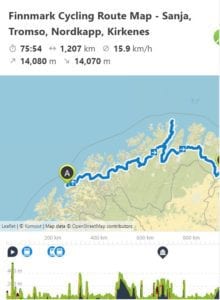
Besides the more beaten way to Nordkapp, this is really a wild ride. Few cars, few tourists, few towns, few people in general… just the great Arctic.
This area of Norway makes for a mostly flat ride for the adventurous bike traveler, its scenery won’t disappoint but distances between grocery supplies might be vast.
From here there are 6 different borders to cross into Finnish Lapland, we went through Helligskogen-Kilipsjarvi, where we found ourselves immersed in an oniric tundra scenario.
Ferries in Norway and Hurtigruten
Unnumerable fjords cut through the mountains along the whole Atlantic Coast, sometimes it is possible to go around them, making the journey much longer, in other cases, the fjords are crossed by futuristic underwater tunnels (almost always forbidden to cyclists), but most of the times ferries are just the way to get across.
Some ferry journeys are very short, with boats going back and forth and riding every 30 minutes or so, those usually cost 7/8€ (a few are free). Other journeys are longer, and often spectacular: the higher costs (300NOK for Hellesylt – Geiranger 1h) feel less of a burden if considering the crossing as a cruise, but they will still weigh heavily on your budget.
The most beautiful ferry ride was from Gudvangen to Kaupanger, 2h 30min of constant awe for the price of 360NOK + 100NOK for a bicycle.
Bikes go free on shorter rides while they are charged a (not so small) fee for longer trips. All the ferries have toilets and cafeterias.
Finding info about prices and schedules online is not always easy, we’ll try to report on what we have done in the upcoming route articles.
A ferry from Bergen to NordKapp – The Hurtigruten
The Hurtigruten is a historical ferry route connecting the whole country, from Bergen to the remote polar area of Kirkenes, since 1893.
The ships go through islets, archipelagos, and towns – some of which are unreachable with ordinary ships and cars. The coastal fleet consists of twelve ships, one departs from Bergen every day.
Hopping on a Hurtigruten ship can be a cool experience, admiring the coast from a different perspective. The ships are nice and comfortable, but as usual not cheap.
We took the Hurtigruten ship from Kristiansund to Brekstad in the Trondheim fjord, about 3h for 600NOK.
Food and drinks in Norway

Among the many things Norway is famous for, it certainly isn’t its cuisine. Maybe because very few get to try it, given the crazy prices.
Besides that, there are not many restaurants around the Norwegian countryside/wilderness. When on a bike trip in Norway one would have to rely on supermarkets and his/her own cooking gear.
Supermarkets in Norway
There are a few supermarket chains that dominate Norway (REMA, Kiwi, Bunnpris), and at least one of these is present in almost every town, you can just use Google Maps to locate them. In some areas of the north, there might be a full day ride between two supermarkets, keep in mind that all of them except some Bunnpris, are closed on Sunday.
Those supermarkets are expensive and do not offer a very wide choice, we relied mostly on canned legumes, pasta, rice, bread, and cheese. You won’t find much processed food here, which is good for the health of Norwegians but somehow inconvenient to the lazy bike tourer.
We know of other experienced bike travelers having luck in resorting to dumpster diving (getting food that would otherwise be trashed from supermarkets). We stupidly never tried it, it could be a great and sustainable way to cut the costs of traveling in Norway.
Drinking Alcohol in Norway
Norway has a very strict regulation about alcohol sale and consumption, which together with the high prices, results in a sort of prohibition for the poor bike adventurer.
Supermarkets are allowed to sell beer up to 4.5°, until 8 pm during the week and 6 pm on Saturdays. No alcohol can be purchased on Sundays. Stronger drinks such as wine and liquors are sold only in state-owned shops, under the judging eye of the usual middle-aged clerk.
Bars are rare and very expensive, there are very few of them (if none at all) in the small towns. 8/10€ for a draft beer. So Norwegians mostly bring home their alcohol problems and get wasted in front of TV screens. We honestly don’t think this is the way to solve a country’s drinking issues.
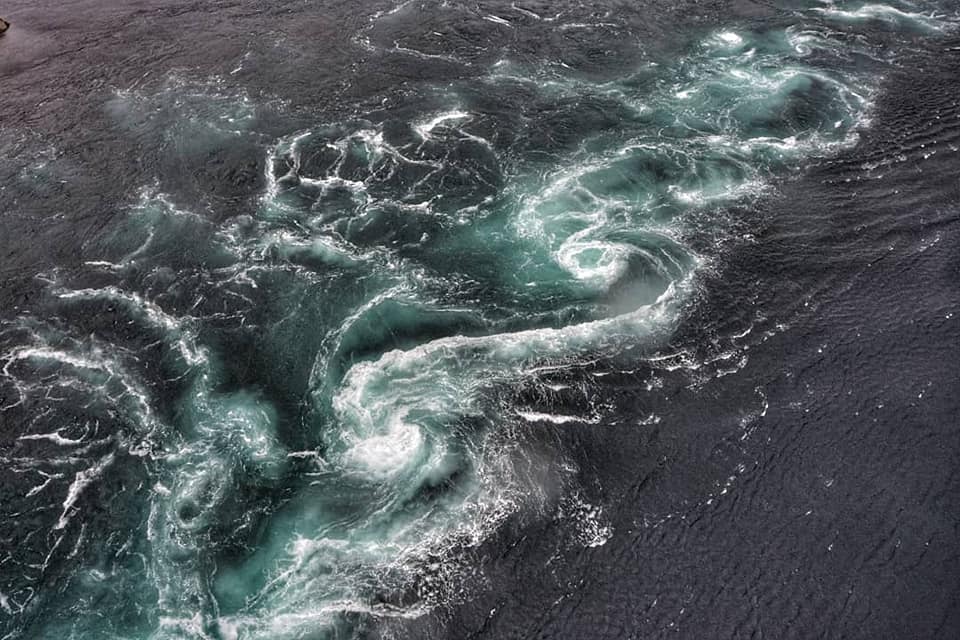
Water supplies
Tap water is among the best in the world in Norway. In the mountains (even just above 800msl) is even possible to drink directly from streams, drink only from fast-running waters.
Did you find this useful? Please share and give us a follow on social networks.


